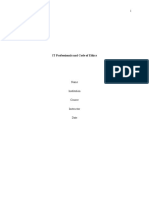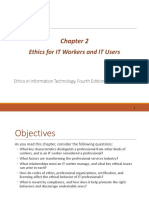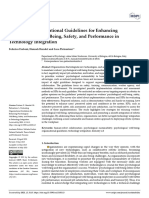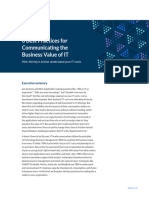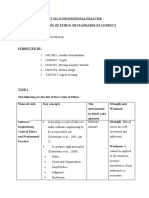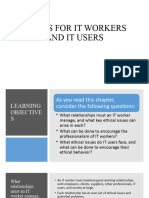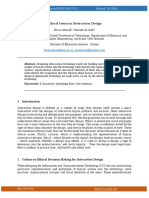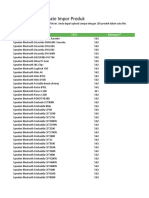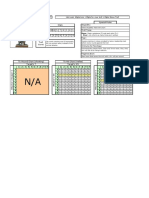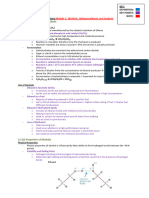0 ratings0% found this document useful (0 votes)
9 viewsWorksheet 3
Worksheet 3
Uploaded by
Maricar LigtasThe document provides examples of best practices for managing relationships between IT workers and different individuals/groups:
1) Between IT workers and employers, it's best for both parties to agree upfront on key job details like title, responsibilities, salary, etc.
2) Between IT workers and suppliers, maintaining open communication can foster innovation, though suppliers must avoid unethical gifts intended as bribes.
3) Between IT workers and users, workers should understand user needs and capabilities to deliver appropriate technology solutions within budget and time constraints.
4) Between IT workers and other professionals, experienced workers can mentor newcomers and ensure adherence to ethical standards, strengthening the integrity of the IT community.
5
Copyright:
© All Rights Reserved
Available Formats
Download as DOCX, PDF, TXT or read online from Scribd
Worksheet 3
Worksheet 3
Uploaded by
Maricar Ligtas0 ratings0% found this document useful (0 votes)
9 views4 pagesThe document provides examples of best practices for managing relationships between IT workers and different individuals/groups:
1) Between IT workers and employers, it's best for both parties to agree upfront on key job details like title, responsibilities, salary, etc.
2) Between IT workers and suppliers, maintaining open communication can foster innovation, though suppliers must avoid unethical gifts intended as bribes.
3) Between IT workers and users, workers should understand user needs and capabilities to deliver appropriate technology solutions within budget and time constraints.
4) Between IT workers and other professionals, experienced workers can mentor newcomers and ensure adherence to ethical standards, strengthening the integrity of the IT community.
5
Copyright
© © All Rights Reserved
Available Formats
DOCX, PDF, TXT or read online from Scribd
Share this document
Did you find this document useful?
Is this content inappropriate?
The document provides examples of best practices for managing relationships between IT workers and different individuals/groups:
1) Between IT workers and employers, it's best for both parties to agree upfront on key job details like title, responsibilities, salary, etc.
2) Between IT workers and suppliers, maintaining open communication can foster innovation, though suppliers must avoid unethical gifts intended as bribes.
3) Between IT workers and users, workers should understand user needs and capabilities to deliver appropriate technology solutions within budget and time constraints.
4) Between IT workers and other professionals, experienced workers can mentor newcomers and ensure adherence to ethical standards, strengthening the integrity of the IT community.
5
Copyright:
© All Rights Reserved
Available Formats
Download as DOCX, PDF, TXT or read online from Scribd
Download as docx, pdf, or txt
0 ratings0% found this document useful (0 votes)
9 views4 pagesWorksheet 3
Worksheet 3
Uploaded by
Maricar LigtasThe document provides examples of best practices for managing relationships between IT workers and different individuals/groups:
1) Between IT workers and employers, it's best for both parties to agree upfront on key job details like title, responsibilities, salary, etc.
2) Between IT workers and suppliers, maintaining open communication can foster innovation, though suppliers must avoid unethical gifts intended as bribes.
3) Between IT workers and users, workers should understand user needs and capabilities to deliver appropriate technology solutions within budget and time constraints.
4) Between IT workers and other professionals, experienced workers can mentor newcomers and ensure adherence to ethical standards, strengthening the integrity of the IT community.
5
Copyright:
© All Rights Reserved
Available Formats
Download as DOCX, PDF, TXT or read online from Scribd
Download as docx, pdf, or txt
You are on page 1of 4
Laurence Ligtas
BSIS 2A
Worksheet No. 3
Presenting Organizations’ Best Practices for Managing Corporate
Relationships
Through online sources, provide real-life examples of BEST PRACTICES
on how organizations manage relationships between IT workers and the
enumerated individuals in this module. Give one example for each relationship.
Include your references.
Relationship Example
Between IT Worker and Employer IT workers and an employer typically agree
on the fundamental aspects of a relationship
before the worker accepts an employment
offer. These issues may include job title,
general performance expectations, specific
work responsibilities, drug-testing
requirements, dress code, and location of
employment, salary, work hours, and
company benefits. (Ethics Notes, PET
Engineering College May 2022).
The example above tells that when someone
is looking to join a company for a job, both
the person and the employer usually talk
about important things beforehand to make
sure they're on the same page. These
discussions cover various aspects, like the job
title, what's expected in terms of performance,
the specific tasks involved, whether there's
drug testing, what the dress code is, where the
job is located, how much the salary is, the
Laurence Ligtas
BSIS 2A
typical work hours, and any benefits the
company offers. It's like a mutual
understanding or agreement about the key
details that define the working relationship
between the person and the company. This
way, both parties have a clear picture of what
to expect before officially deciding to work
together.
Between IT Worker and Supplier A good working relationship with suppliers
encourages the flow of useful communication
as well as the sharing of ideas. Such
information can lead to innovative and cost-
effective ways of using the supplier’s
products and services. To achieve this goal,
they may sometimes engage in unethical
actions for example, offering an IT worker a
gift that is actually intended as a bribe. (Ethics
Notes, PET Engineering College May 2022).
Take this an example of me being the
procurement manager at a tech company,
forming a close bond with my key supplier.
One day, the supplier's representative,
knowing he/she's passion for technology,
surprises with an extravagant gift—an
advanced laptop. Little does he/she know, this
seemingly thoughtful gesture is a subtle
attempt to influence upcoming contract
negotiations. The laptop, meant to be a
generous present, doubles as an unethical ploy
to secure favorable business terms.
Between IT Worker and Users IT workers have a duty to understand a user’s
needs and capabilities and to deliver products
and services that best meet those needs -
subject, of course, to budget and time
Laurence Ligtas
BSIS 2A
constraints. (Ethics in IT, Qudsiya Naaz
2019).
Basically, it means IT Worker should listen to
what users want and can handle, then make
tech stuff that fits those needs, as long as it
fits the money and time limits.
Between IT Worker and other Professionals owe each other adherence to the
Professionals professions code of conduct. Experienced
professionals can also serve as mentors and
help develop new members of the profession.
(Ethics in IT, Qudsiya Naaz 2019).
In the realm of IT, experienced IT
professionals play a crucial role in this
ecosystem by serving as mentors to newer
members of the profession. Through
mentorship, they share their knowledge, guide
newcomers in navigating the complex
landscape of technology, and instill a sense of
ethical responsibility. This not only fosters the
growth and development of the individuals
involved but also contributes to the overall
integrity and professionalism of the IT
community. The transfer of experience and
adherence to ethical standards collectively
contribute to a robust and trustworthy IT
sector.
Between IT Worker and Society Society expects members of a profession to
provide significant benefits and to not cause
harm through their actions. It is important to
note that there is currently no single, formal
organization of IT workers that takes
responsibility for establishing and
maintaining standards that protect the public.
Laurence Ligtas
BSIS 2A
(Ethics in IT, Qudsiya Naaz 2019).
In a scenario, consider a freelance software
developer working on a healthcare
application. Without a centralized authority,
this developer may not follow best practices
for securing sensitive patient data, potentially
putting individuals at risk if the application is
not properly safeguarded against cyber
threats. The lack of overarching standards
could lead to inconsistent levels of
professionalism and jeopardize public trust in
IT services.
Between IT Worker and Clients IT workers provide services to clients,
sometimes those “clients” are coworkers who
are part of the same organization as the IT
worker. In other cases, the client is part of a
different organization. Note that in
relationships between IT workers and clients,
each party agrees to provide something of
value to the other. (Ethics in IT, Quadsiya
Naaz 2019).
In an organization, an IT worker could be
providing services to internal coworkers by
maintaining and troubleshooting the
company's internal network and computer
systems. This internal client relationship
involves the IT worker ensuring that
colleagues have reliable access to the
organization's resources, and in return, the
coworkers benefit from a smooth and efficient
digital work environment.
You might also like
- BSBXCM501 Student Assessment Tasks 16-11-20Document19 pagesBSBXCM501 Student Assessment Tasks 16-11-20Jyoti Verma83% (12)
- Kumo Desu Ga, Nani Ka - Vol. 7 (So I'm A Spider, So What) PDFDocument329 pagesKumo Desu Ga, Nani Ka - Vol. 7 (So I'm A Spider, So What) PDFMatia Gabriel86% (14)
- It Professionals: ProfessionDocument2 pagesIt Professionals: ProfessionJanah Andrea RiveraNo ratings yet
- Ehtics For It Workers It UsersDocument15 pagesEhtics For It Workers It UsersGrey'z SantosNo ratings yet
- Esangathan Newsletter 7Document4 pagesEsangathan Newsletter 7Distance ExpertNo ratings yet
- BSBXCM501 A1Document9 pagesBSBXCM501 A1Aaqib SurtiNo ratings yet
- MIS303 Ass3 VojtechStaryDocument9 pagesMIS303 Ass3 VojtechStaryvoytaNo ratings yet
- Assessment Task 1 Written QuestionsDocument12 pagesAssessment Task 1 Written QuestionsClaire Caballero GabrielNo ratings yet
- Assessment 1Document5 pagesAssessment 1Uray FahreziNo ratings yet
- Empowered and Embedded Ethics and Agile ProcessesDocument14 pagesEmpowered and Embedded Ethics and Agile ProcessesElena OpreaNo ratings yet
- Ethical Protocols in Professional PractiDocument6 pagesEthical Protocols in Professional PractiTae bah BatoolNo ratings yet
- Information Technology For Management by Mohamed Minhaj (ITFM)Document9 pagesInformation Technology For Management by Mohamed Minhaj (ITFM)Shyamanth R KavimaneNo ratings yet
- The Importance of Ethics Among IT ProfessionalsDocument6 pagesThe Importance of Ethics Among IT Professionalssyida1990No ratings yet
- Tasik 2Document6 pagesTasik 2Mohammad AlyNo ratings yet
- Team Effectiveness in Software Development: The Role of Personality and Work FactorsDocument15 pagesTeam Effectiveness in Software Development: The Role of Personality and Work FactorsBENJAMIN WESLEY MENDOZA GOMEZNo ratings yet
- IT0025 - M1 - Social and Professional IssuesDocument21 pagesIT0025 - M1 - Social and Professional IssuesTricia ReloxNo ratings yet
- IT Professionals and Code of EthicsDocument5 pagesIT Professionals and Code of EthicsAllan njorogeNo ratings yet
- TL Khac 1 Thakur AlSaleh Hale 2023 Digital Disruption a Managers Eye View 2023Document18 pagesTL Khac 1 Thakur AlSaleh Hale 2023 Digital Disruption a Managers Eye View 2023Nguyễn Thiên KimNo ratings yet
- The Importance of Ethics Among The IT ProfessionalsDocument4 pagesThe Importance of Ethics Among The IT Professionalsichhy_bunNo ratings yet
- Chapter 2 Ethics For It Professional & It UserDocument3 pagesChapter 2 Ethics For It Professional & It UserNovi AnaNo ratings yet
- 9 Benefits of Using Hybrid It ModelsDocument6 pages9 Benefits of Using Hybrid It Modelsandini eldanantyNo ratings yet
- Relationship Between Computer-Mediated Communicati PDFDocument20 pagesRelationship Between Computer-Mediated Communicati PDFsafa haddadNo ratings yet
- The Importance of Talent and Culture in Tech Enabled TransformationsDocument7 pagesThe Importance of Talent and Culture in Tech Enabled TransformationsgtoutianNo ratings yet
- Workplace ImpactDocument11 pagesWorkplace ImpactKingsley SimonNo ratings yet
- Pluralsight PrepStudents EDU WhitepaperDocument7 pagesPluralsight PrepStudents EDU WhitepaperGustavo FonsecaNo ratings yet
- Project Employee EngagementDocument34 pagesProject Employee EngagementSuruchi Goyal86% (7)
- IT-Business Alignment: A Systematic Literature Review IT-Business Alignment: A Systematic Literature ReviewDocument8 pagesIT-Business Alignment: A Systematic Literature Review IT-Business Alignment: A Systematic Literature Reviewfahmi abdillahNo ratings yet
- 1 - Composable DevOps Automated Ontology Based DevOps Maturity AnalysisDocument8 pages1 - Composable DevOps Automated Ontology Based DevOps Maturity AnalysisSohaib RehmanNo ratings yet
- TITAN Dossier 2020-21Document41 pagesTITAN Dossier 2020-21Amit KumarNo ratings yet
- 307 ArticleText 885 1 10 202407192Document28 pages307 ArticleText 885 1 10 202407192Bendout BSANo ratings yet
- Digital Transformation, Soft Skills, The Perfect Productivity Combination!Document15 pagesDigital Transformation, Soft Skills, The Perfect Productivity Combination!IJAR JOURNALNo ratings yet
- TC 1 IntroDocument14 pagesTC 1 IntrololnodudeborshismineNo ratings yet
- Cognizant Center For The Future of Work - CognizantDocument24 pagesCognizant Center For The Future of Work - CognizantThiago TrindadeNo ratings yet
- Case Study April 13Document3 pagesCase Study April 13Wenz Carlo DuenaNo ratings yet
- Running Head: Computer Professional EthicsDocument4 pagesRunning Head: Computer Professional EthicsAmoke MusaNo ratings yet
- Chapter 2-1Document44 pagesChapter 2-1dr.soufy.syNo ratings yet
- Chapter 2 Ethics For IT Workers and IT UserDocument45 pagesChapter 2 Ethics For IT Workers and IT UserjustdourworkNo ratings yet
- Fraboni Et Al., 2023 - Evaluating Organizational GuidelinesDocument17 pagesFraboni Et Al., 2023 - Evaluating Organizational GuidelinesMuhammad Wasaam AliNo ratings yet
- Looking For A Better IT Project Manager Try The Hybrid ModelDocument5 pagesLooking For A Better IT Project Manager Try The Hybrid ModelJohn evansNo ratings yet
- T Issa - CCV2010 - Paper PDFDocument7 pagesT Issa - CCV2010 - Paper PDFProcurement LNSP LabNo ratings yet
- Big Digital Leadership - The Future of WorkingDocument7 pagesBig Digital Leadership - The Future of WorkingFuture of WorkingNo ratings yet
- Employee Engagement Using Artificial Intellegence: PG Student, School of Management, D.G. Vaishnav CollegeDocument6 pagesEmployee Engagement Using Artificial Intellegence: PG Student, School of Management, D.G. Vaishnav CollegeRiyazNo ratings yet
- MICS SuggestedDocument29 pagesMICS Suggestedanishphuyal987No ratings yet
- Tomayess Issa 2010 Sustainable Business Strategies and Pestel PDFDocument8 pagesTomayess Issa 2010 Sustainable Business Strategies and Pestel PDFLee YqNo ratings yet
- WE Framework DigDocument10 pagesWE Framework Digs3rinadataNo ratings yet
- Tumbas Berentevom Brockeforthcoming JITDigital Innovationand Institutional EntrepreneurshipDocument38 pagesTumbas Berentevom Brockeforthcoming JITDigital Innovationand Institutional Entrepreneurshipdslr.holmgrenNo ratings yet
- 6-best-practices-to-communicate-it-valueDocument6 pages6-best-practices-to-communicate-it-valueDan MondsheinNo ratings yet
- Conquering The Neurodiversity Frontier FDocument3 pagesConquering The Neurodiversity Frontier FVitor Buenos-Aires LuzNo ratings yet
- Professional PracticeDocument7 pagesProfessional PracticeAli HaiderNo ratings yet
- Leader-Member Exchange TheoryDocument4 pagesLeader-Member Exchange TheoryDennis N. MurimiNo ratings yet
- Boxwood What Is A Technology Operating Model' and Which Should I HaveDocument4 pagesBoxwood What Is A Technology Operating Model' and Which Should I HavesolsolidNo ratings yet
- Final Assignmenr521Document10 pagesFinal Assignmenr521Ugyen KezangNo ratings yet
- Scrib 2Document17 pagesScrib 2Muhammad WaleedNo ratings yet
- Lesson 2Document20 pagesLesson 2Christa WilliamsNo ratings yet
- Managing and Using Information Systems1 - PARTICIPATION OF MANAGERSDocument28 pagesManaging and Using Information Systems1 - PARTICIPATION OF MANAGERSsucrooNo ratings yet
- 01 - Ghosh and Scott (2009)Document11 pages01 - Ghosh and Scott (2009)Kata BorsiNo ratings yet
- Ethical Issues in Interaction DesignDocument8 pagesEthical Issues in Interaction DesignShahbazAliMemonNo ratings yet
- Ethics by Design 1608563252Document37 pagesEthics by Design 1608563252Adrian CristinaNo ratings yet
- Chapter 10- What to Do about Shadow IT?Document15 pagesChapter 10- What to Do about Shadow IT?jiholambertiNo ratings yet
- Unit 3: IT Impacts: NotesDocument8 pagesUnit 3: IT Impacts: NotesppghoshinNo ratings yet
- Enterprise Architect’s Handbook: A Blueprint to Design and Outperform Enterprise-level IT Strategy (English Edition)From EverandEnterprise Architect’s Handbook: A Blueprint to Design and Outperform Enterprise-level IT Strategy (English Edition)No ratings yet
- Speaker Das-Toped-Part1Document145 pagesSpeaker Das-Toped-Part1pandu prakosoNo ratings yet
- (Studies on Entrepreneurship, Structural Change and Industrial Dynamics) Tessaleno Devezas, João Leitão, Askar Sarygulov (Eds.)-Industry 4.0_ Entrepreneurship and Structural Change in the New DigitalDocument426 pages(Studies on Entrepreneurship, Structural Change and Industrial Dynamics) Tessaleno Devezas, João Leitão, Askar Sarygulov (Eds.)-Industry 4.0_ Entrepreneurship and Structural Change in the New Digitalagastya100% (4)
- Monsters of Murka v1.31Document111 pagesMonsters of Murka v1.31paxtone91No ratings yet
- Quater 1 Module 2Document5 pagesQuater 1 Module 2Philip John QuinonesNo ratings yet
- Thiet Bi Bao Ve He Thong Dien PDFDocument215 pagesThiet Bi Bao Ve He Thong Dien PDFtranhuutuongNo ratings yet
- Course Outline EDEM 511Document2 pagesCourse Outline EDEM 511Rose DumayacNo ratings yet
- Troll Warhammer ChartsDocument2 pagesTroll Warhammer ChartstristanludlowNo ratings yet
- Mts 004872Document36 pagesMts 004872Kiplagat ChelelgoNo ratings yet
- Pit Viper Atlas CopcoDocument5 pagesPit Viper Atlas CopcoIvan EstebanNo ratings yet
- Vps 700Document2 pagesVps 700زكي النعيميNo ratings yet
- A Theoretical Framework For DramaDocument9 pagesA Theoretical Framework For DramaDespina Kalaitzidou0% (2)
- 1 s2.0 S0011227523000450 MainDocument6 pages1 s2.0 S0011227523000450 MainRev TamasNo ratings yet
- Telegram Channel: @ieltsc1: Reading Passage 1Document4 pagesTelegram Channel: @ieltsc1: Reading Passage 1muhammad bilalNo ratings yet
- Reading Comprehension and Reading Passages - Madison and CarsonDocument5 pagesReading Comprehension and Reading Passages - Madison and Carsonwennykwok96No ratings yet
- Vehicle - Terrain SystemsDocument80 pagesVehicle - Terrain Systemsmohamed magdyNo ratings yet
- Rondebosch Boys' High School: Senior CertificateDocument10 pagesRondebosch Boys' High School: Senior CertificateChey1242No ratings yet
- Comparatives-And-Superlatives-Pamela - Class 10Document7 pagesComparatives-And-Superlatives-Pamela - Class 10pamelaNo ratings yet
- Zoomlion QUY260 Crawler CraneDocument24 pagesZoomlion QUY260 Crawler CraneMandiri CraneNo ratings yet
- 10705SI001 - Ghangaru Bahuni Khola IPDocument112 pages10705SI001 - Ghangaru Bahuni Khola IPSharad PanditNo ratings yet
- IE in Garment IndustryDocument4 pagesIE in Garment IndustryRaaj DasNo ratings yet
- Experiment 2 EST OLIVA PDFDocument13 pagesExperiment 2 EST OLIVA PDFMark joseph BayletNo ratings yet
- Pol180 - Global Sociology (R.cohen)Document6 pagesPol180 - Global Sociology (R.cohen)leongentismNo ratings yet
- Assignment - 1Document6 pagesAssignment - 1Fahad IqbalNo ratings yet
- BEE3 EdaDocument2 pagesBEE3 Edaindiahind531No ratings yet
- 2 Day Website FormatDocument18 pages2 Day Website FormatPanacorp ResearchNo ratings yet
- Sedative Effect of Citronella (Cymbopogon Nardus (L.) Rendle) Towards Male Mice (Mus Musculus)Document8 pagesSedative Effect of Citronella (Cymbopogon Nardus (L.) Rendle) Towards Male Mice (Mus Musculus)aprizaNo ratings yet
- 1ST QUARTER SCIENCE Module 5.1Document13 pages1ST QUARTER SCIENCE Module 5.1Cian Benedict BeltranNo ratings yet
- Hohepa ART D1 PG2Document4 pagesHohepa ART D1 PG2ngatihuraNo ratings yet
- OCR A Chemistry Module 2 Unit 2 Revision NotesDocument8 pagesOCR A Chemistry Module 2 Unit 2 Revision Notescxmsq6rry2No ratings yet
















